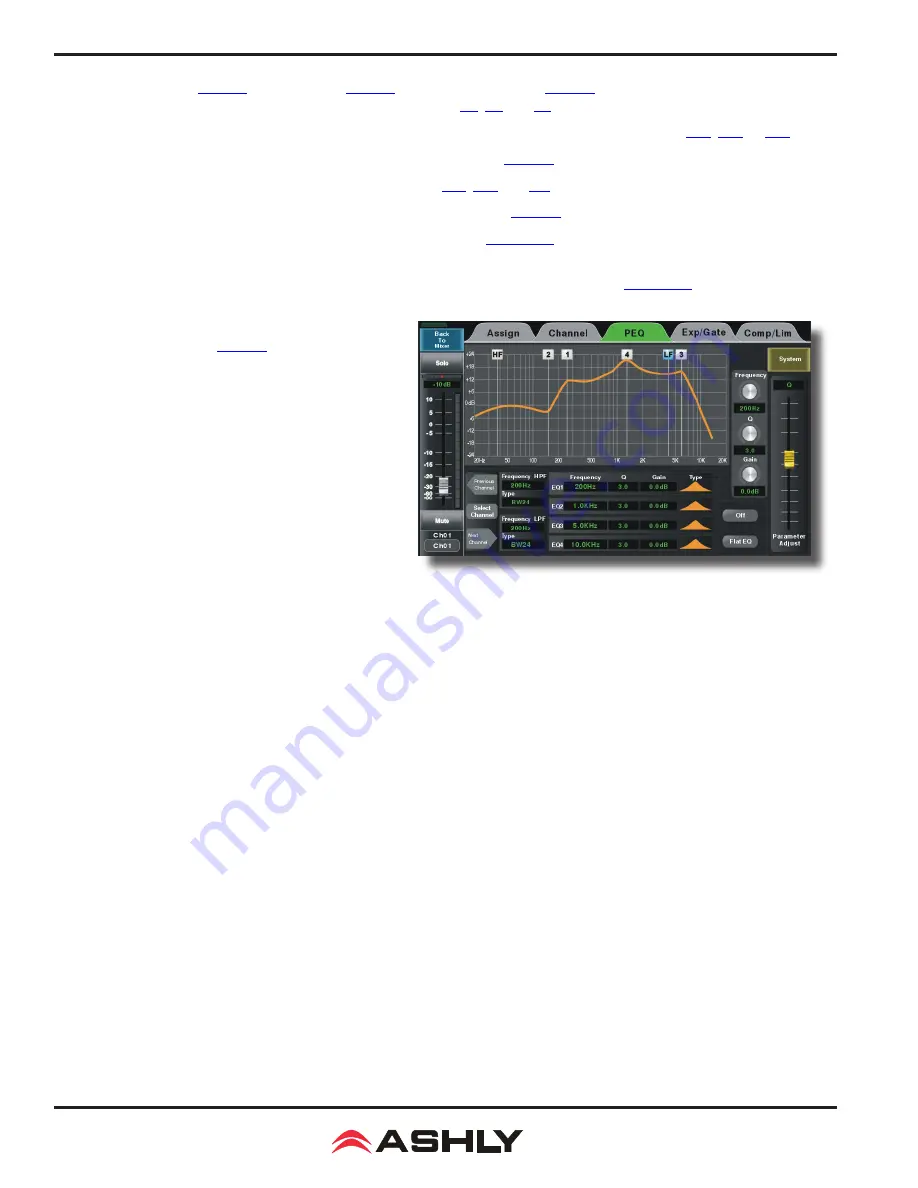
Operating Manual - digiMIX24 Digital Mixer
16
7) Adjust PEQ (
sec. 2.40
), expander/gate (
sec. 2.42
), and compressor/limiter (
sec. 2.43
) on each input channel as needed. For
greater details and examples of how to use these functions, see sections
4.2
,
4.4
, and
4.5
.
8) Assign the aux output(s) for all used input channels, adjusting their level to each monitor mix. (sec.
2.10
,
2.38
, or
2.45
)
9) Use the master aux level controls to set each overall monitor level (
sec. 2.10
)
10) Apply effects to input channels if desired. See sections
2.12
,
2.44
, and
4.8
for details and examples.
11) Adjust GEQ graphic equalizer for main, aux, or subgroup outputs. (
sec. 2.41
)
12) To create a vocal or other subgroup, follow the instructions in
section 2.11
, then select the subgroup to adjust the group
level using the main fader.
13) To create a DCA level or mute group for all vocals or other groups, follow instruction in
section 2.16
, then select the DCA
group before using the main fader or mute button.
14) Save settings as scene presets, DSP channel presets,
FX presets, or GEQ presets (
sec. 2.31
).
4.2 PEQ Parametric EQ
Press the PEQ button to engage the parametric EQ for the
currently selected input channel, subgroup, main output, FX,
or aux output. The four filters EQ1-EQ4 can be shelving
or parametric, with additional hi-pass and low-pass filters.
Shelving Filters:
EQ1-EQ4 can be set as tuneable shelving
filters, typically used as the high and low boost/cut controls.
Press the filter <Type> image on the touchscreen to toggle
between low shelf, high shelf, or parametric peak filter.
Parametric Filters
can adjust frequency, bandwidth (Q),
and filter gain/cut. Think of one band of parametric EQ as a
single graphic equalizer fader where the frequency is variable,
and the bandwidth (Q) is also variable. The smaller the bandwidth, the less the audio signal on either side of the frequency center
is boost or cut, whereas a wider bandwidth produces a more audible change to the overall tone of a signal. In addition to basic
tone controls, parametric filters are ideal for eliminating problem feedback frequencies without greatly affecting the overall
sound. They are also useful for adding or removing a characteristic hot spot from microphones or for precisely compensating
for room resonance. It is well worth the time becoming proficient with parametric EQ filters, as they offer the best solution to
many EQ problems.
HPF/LPF:
The hi-pass and low-pass filters are cut only, with adjustable frequency and slope. There are 20 different filter types
to choose from including Butterworth, Bessel, and Linkwitz-Riley, with filter slopes ranging from 6db/oct to 48dB/oct. These
filters are typically used to limit bandwidth. A common application is to use an aux output to drive 70V transformer tapped
speakers that are not suited for signal below 80Hz. Set the HPF for that Aux output to 80Hz, then select the desired filter type.
Tone Control:
The four EQ filters can be used as basic tone controls with tuneable frequencies, ie high, high-mid, low-mid,
and low. High and low typically use shelving filters. Press the <Flat EQ> button to restore all filters to 0dB gain, medium Q,
and default starting frequencies and filter types. A lower Q broadens the filter to have a much greater effect, while a higher Q
narrows the bandwidth and makes less of an overall difference when boost or cut.
Notch EQ for Feedback Control:
To eliminate a feedback problem on a live mic input, set the PEQ flat and turn up the mi
-
crophone level until it is on the edge of feedback. Then using the frequency control, sweep a narrower bandwidth (higher Q)
filter through a problem feedback area, with just a slight amount of gain on that filter, until finding the exact frequency causing
feedback. Once the feedback frequency has been identified, reduce the filter's gain until feedback is gone. Adjust the bandwidth
(Q) as narrow as possible while still eliminating feedback. Repeat with additional filters and frequencies as necessary. Finding
the problem frequency is relatively easy, but finding the best combination of minimal cut and bandwidth takes a little practice.
Notch EQ for Room Resonance:
To reduce excess reverberation or boominess in a room, use the parametric filter on the main
or aux outputs. With music playing through the speakers, engage a PEQ filter on the output, then sweep the filter's frequency
with a slight boost and medium Q until you hear a disproportionate increase in the boominess of the music. This frequency is a
room resonance, and can be notched to compensate. Adjust the bandwidth and cut only as little as necessary to fix the problem.
Figure 4.2: PEQ Parametric EQ Screen






























